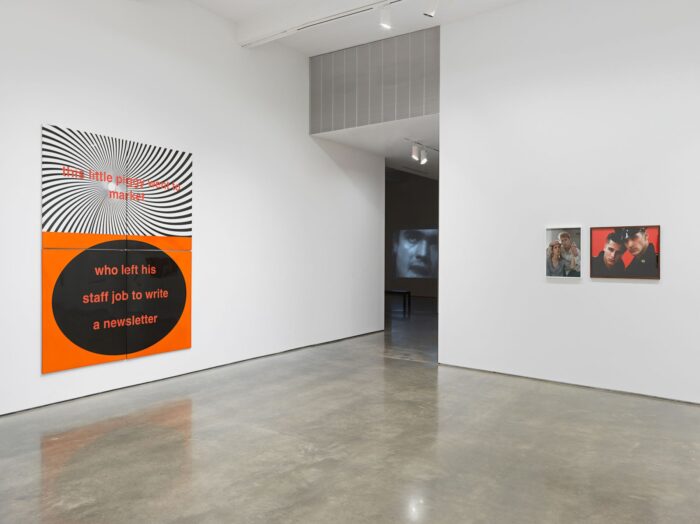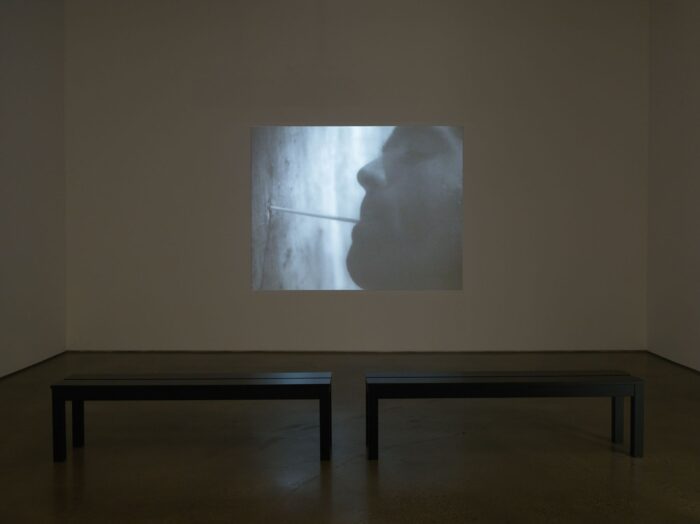







Wish group show at Metro Pictures Gallery
June 17 – August 6, 2021
All images courtesy of Metro Pictures Gallery
Wish brings together works by Reza Abdoh, Jean Genet, Nash Glynn, Torbjørn Rødland, Elliot Reed, Heji Shin, and Nora Turato. In his seminal book The Interpretation of Dreams (1900), Freud asserts that every dream is the expression of a wish. However, in dreams these repressed wishes often manifest themselves in distorted form in order to be tolerable to the dreamer. The works in the exhibition can be viewed as dream-images that represent desires considered too uncomfortable, taboo or salacious to the conscious mind. Wish is intended to unfold like a dream, with the wish exemplified by each artwork made available to viewers for interpretation.
In Jean Genet’s 1950 film Un chant d’amour, a voyeuristic prison guard excitedly leers at prisoners in their cells. In one well-known scene, he observes two prisoners struggle for intimacy despite the wall that separates their cells. The first man lustfully kisses around a hole in the wall while the second sticks a long straw through it. Bending in front of the straw, his eyes closed and mouth wide open, he waits to receive something from his neighbor, who delightedly drags on a cigarette and leans down to exhale into it. A great gust of smoke shoots through onto the second man’s face before he wraps his lips around the straw, taking in the exhalation.
Torbjørn Rødland’s Intraoral no. 2 repeats the image of the open-mouthed man in Genet’s film. A figure reclines in a dentist’s chair, the mouth centered in the frame while a latex-gloved hand pulls down the bottom lip. Rødland’s photographs capture unsettling or bizarre moments in otherwise mundane scenes similar to everyday life. This incongruity, emphasized by a slick formal language that is informed by commercial photography, suggests narratives of seduction, perversity and disquiet.
Heji Shin photographed male models in NYPD uniforms and staged a porn shoot to make her series “Men Photographing Men.” The works engage the familiar “man in uniform” trope commonly enacted in, for example, the banal ritual of the bachelorette party. The porno cops arrive on the scene to titillate, whether to satisfy a rescue fantasy or, conversely, a masochistic desire to be punished and subjugated.
The design of Nora Turato’s hand-painted text-work is loosely based on the movie poster for director Todd Haynes’s Genet-inspired film Poison. The text reads, “This little piggy went to market/who left his job to write a newsletter.” Turato continually logs text from newspapers, the internet, social media, and advertisements into documents she calls “pools”—reserves of collected text she continually updates and ultimately publishes in book form or memorizes and delivers in performances. The “little piggy” in Turato’s phrase calls to mind the cops in Shin’s photographs and the prison guard in Genet’s film. Punning is among the various types of distortions used in dreams, according to Freud. Such puns make desires more palatable to the conscious mind. This logic can be observed in the titling of Shin’s photograph of a magnificent rooster, BIG COCK 7.
An oversized figure sits nude on a sweeping green field in Nash Glynn’s untitled self-portrait. Her head is turned away from the viewer with one breast visible as she stares off into the distant landscape, which is dominated by a dramatic pink and blue sky. One leg is tucked beneath her and the other is bent, giving just a glimpse of her cock and balls. A vague, illegible rectangle stands erect on the horizon. The painting depicts a trans female colossus in a dreamscape in which the penis does not function as the phallic signifier of masculinity.
The Hip-Hop Waltz of Eurydice was written and directed by Reza Abdoh. The exhibited video is a recording from a 1990 performance of the play at the Los Angeles Theatre Center. In the original myth Orpheus descends to the underworld in order to bring his wife Eurydice back to the world of the living with him. His request is permitted but under the condition that he never looks back at his wife before leaving. Uncertain that Eurydice follows behind, Orpheus turns back just before exiting and loses her forever. In Abdoh’s interpretation of the myth, the couple have a forbidden love and their sexuality is repressed by the unsightly, fat-cat Hades.
Elliot Reed’s sculpture End-To-End Encrypted (Lot’s Wife) was inspired by the interruption of relationships by travel restrictions during the pandemic. An amount of crushed curing salt equal to Reed’s bodyweight is piled oblong on the floor. On top of the salt is every article of clothing the artist wore during a videocall with his partners during which he sang a love song. Reed’s chosen materials reference the biblical story of Sodom and Gomorrah. Angels warned Lot and his family of the cities’ pending destruction. In exchange for this information, the angels would grant them safe passage, provided the family never looks back. Lot’s wife was the only one unable to bear the pain of her decimated home. She looked over her shoulder and was instantly transformed into a pillar of salt.
